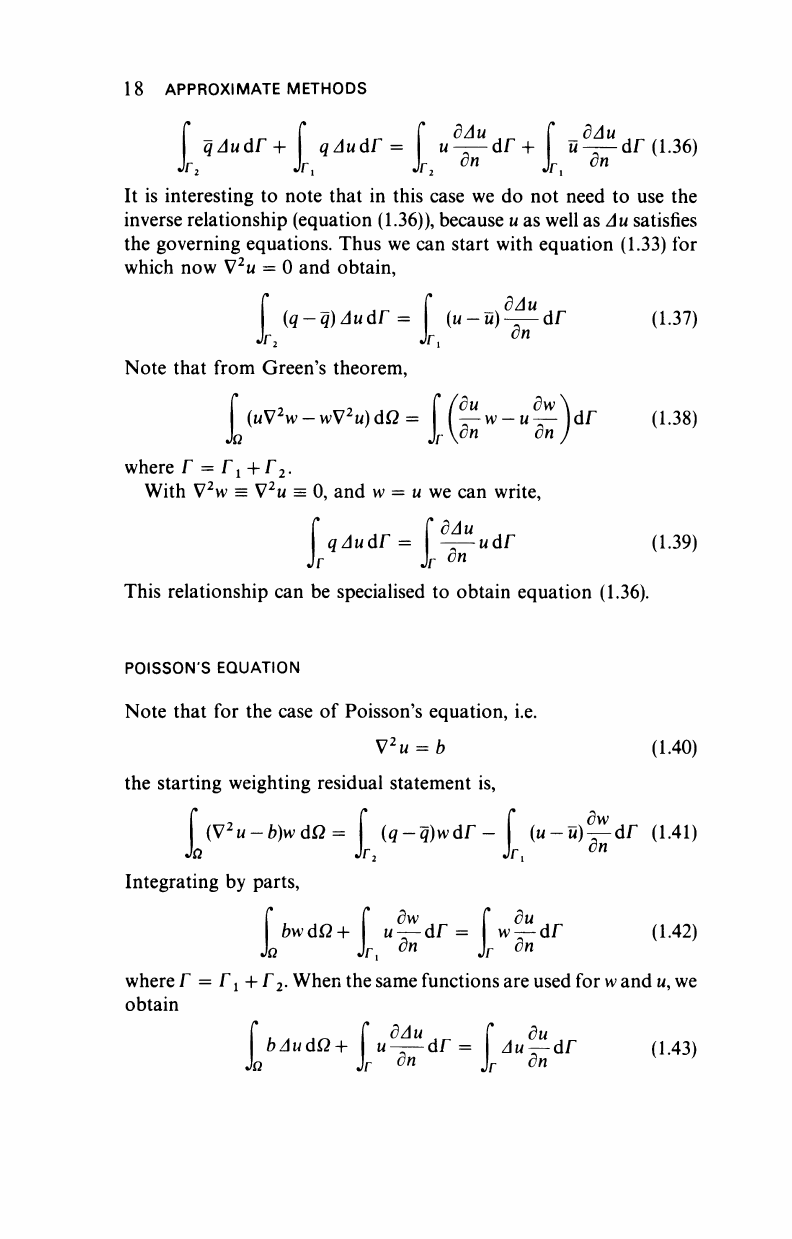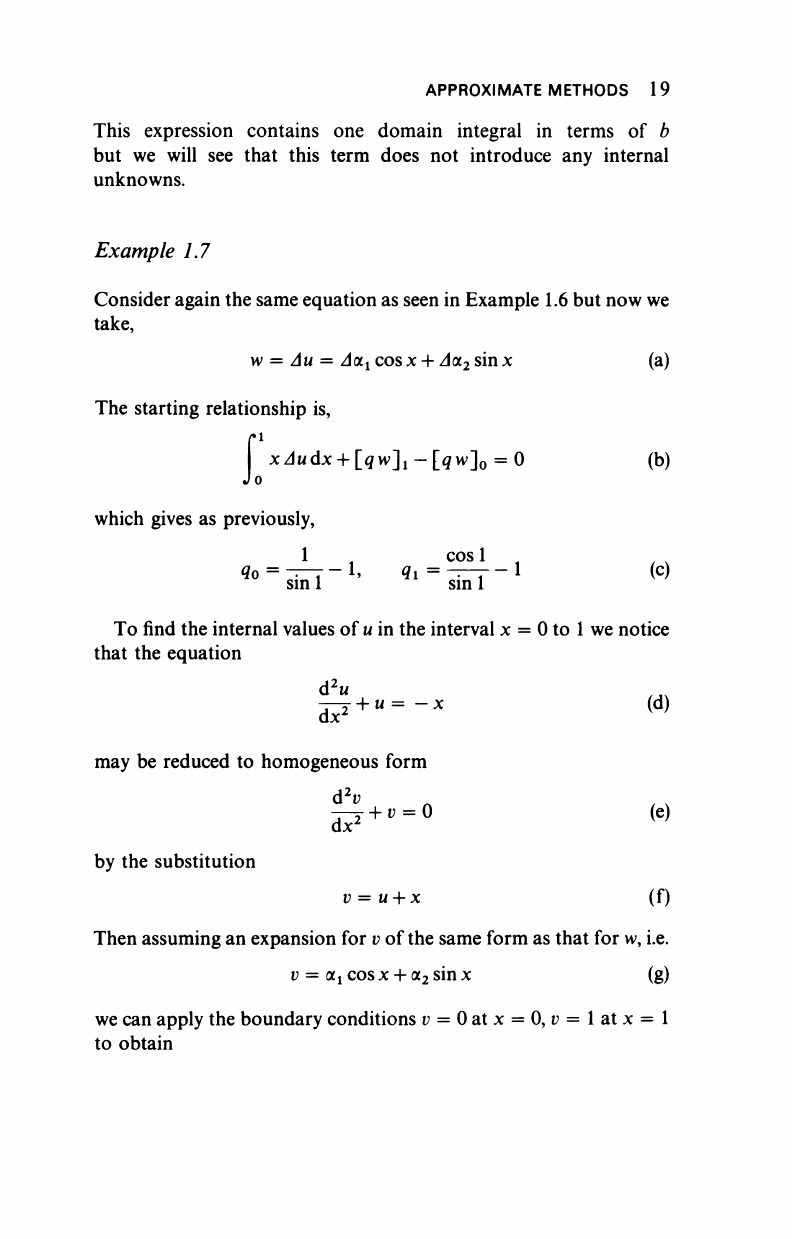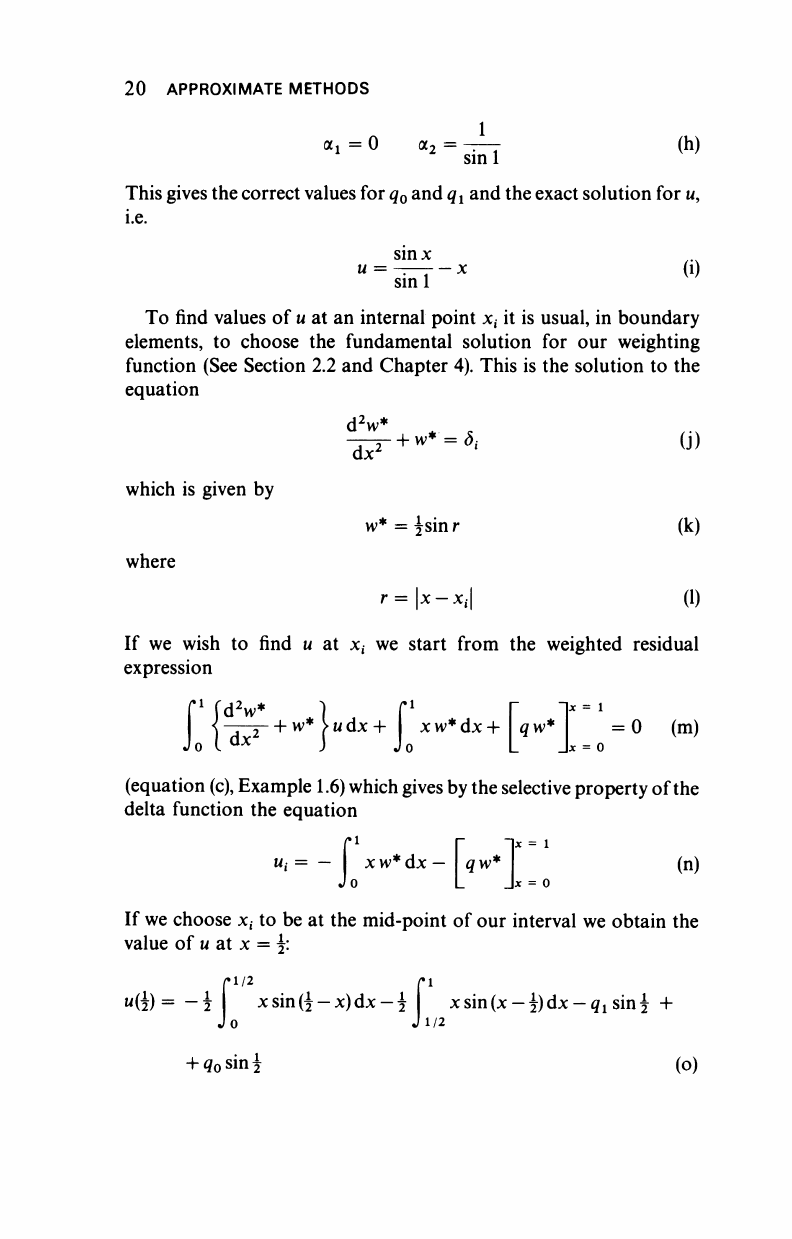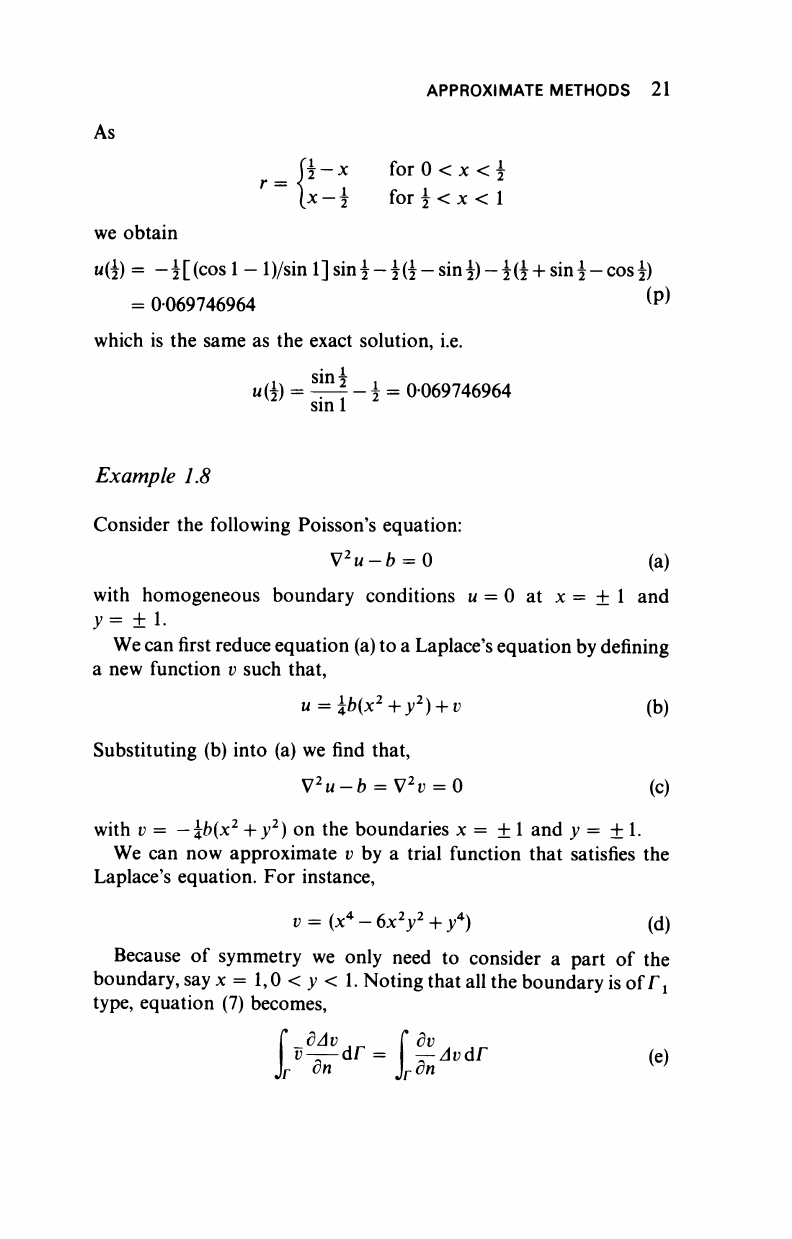
APPROXIMATE METHODS 17
Note that the solution for u and
w
can be of any form and that these
functions
are
defined only on the boundary. In this particular example
the boundary reduces to two points, hence we have as unknowns, q
0
and q
l
(i.e. dw/dx at 1 and 0).
Consider now equation (c) and substitute into it the weighting
function (e). This gives,
•1
x
w
dx + [q w]
x
— \_q
w]
0
= 0
Jo
•1
xOS
1
cosx-hj8
2
s
i
nx
)
(
ix + ^i(jSiCOsl +/?
2
sin
1) —
q
0
(ßi) = 0
Jo
This gives the following equations (note that β
γ
and ß
2
are
arbitrary):
•1
xcosxdx =
—
(q
l
cos
1 —
q
0
)
f
Jo
f
ί
1
xsinxdx =
—
q
l
sin 1
o
COsl
i
l
1 r
sin
1
sin
1
These are exact boundary fluxes du/dx at x = 1 and du/dx at x = 0
1.5 BOUNDARY METHODS
The last example showed an application of
the
inverse relationship to
find a boundary solution. Let us now try to use the integrals seen in
Section 1.3 to establish boundary solutions. Assume for instance, that
we have a w function such that V
2
w = 0. Hence formula (1.34)
becomes,
I qwdr+ I qwdr= u^-άΓ + | ΰ^-άΓ (1.35)
Jr
2
Jr
t
Jr
2
Jr
x
This relationship is the starting point for the 'direct' boundary
element method.
If the same functions are used for
w
as for the approximate function
u, one can write,

1
8 APPROXIMATE METHODS
qAudf+
qAudf=
]
r
l
f
2
u—-dr +
on
'^1
ü^df(1.36)
on
It is interesting to note that in this case we do not need to use the
inverse relationship (equation (1.36)), because u as well as Au satisfies
the governing equations. Thus we can start with equation (1.33) for
which now V
2
w = 0 and obtain,
(q —
q)Audr =
Note that from Green's theorem,
(uV
2
w-wV
2
w)dß =
I
(u-^är
(du dw
|
r
on on
(1.37)
(1.38)
where Γ = r
t
+Γ
2
.
With V
2
w =
V
2
M
= 0, and w = u we can write,
I
qAudi=
Ϊ
d_Au
udr
(1.39)
This relationship can be specialised to obtain equation (1.36).
POISSON'S EQUATION
Note that for the case of Poisson's equation, i.e.
V
2
u = b
the starting weighting residual statement is,
(1.40)
(V
2
u-b)wdQ = (q-q)wdr- (u-u)^dr (1.41)
Integrating by parts,
bwdQ +
8w
ΑΓ
u—-di
=
on
i vv—-di
r
on
(1.42)
where Γ =
Γ
1
--Γ
2
.
When the same functions are used for
w
and
u,
we
obtain
Γ
Γ A
A
Γ %
bAudQ + u—^-dr= Au^-άΓ (1.43)
b Jr
dn
Jr
d
"

APPROXIMATE METHODS 19
This expression contains one domain integral in terms of b
but we will see that this term does not introduce any internal
unknowns.
Example 1.7
Consider again the same equation as seen in Example 1.6 but now we
take,
w = Au = /do^cosx + z^sinx (a)
The starting relationship is,
idx + [qw]
l
-[qw]
o
= 0 (b)
xAui
Jo
which gives as previously,
1
i cos
1
sin
1
sin
1
To find the internal values of
u
in the interval x = 0 to 1 we notice
that the equation
d^w
dx
2
+
u
= - x (d)
2
+ v = 0 (e)
may be reduced to homogeneous form
ah
dx
by the substitution
v =
u
+ x (f)
Then assuming an expansion for v of the same form as that for w, i.e.
v = a
1
cosx + a
2
sinx (g)
we can apply the boundary conditions f = 0atx = 0, f = latx=l
to obtain

20 APPROXIMATE METHODS
α
1=
0 α
2
=^ (h)
This gives the correct values for q
0
and q
x
and the exact solution for u,
i.e.
sinx
u = -— - x (ι)
sinl
To find values of
u
at an internal point x, it is usual, in boundary
elements, to choose the fundamental solution for our weighting
function (See Section 2.2 and Chapter 4). This is the solution to the
equation
d
2
w*
—
r
+ ^ = S
i
(j)
dx
2
which is given by
where
w* = ^sin
r
(k)
r = |x
—x
f
|
(1)
If
we
wish
to
find
u at x, we
start from
the
weighted residual
expression
<-v^- +
vv*
iudx-h xw*dx+Lw* =0 (m)
(equation (c), Example 1.6) which gives by the selective property of the
delta function the equation
U: = -
o
MÜ
x w* dx
—
qw* (n)
If we choose
x
f
to be at the
mid-point
of
our interval
we
obtain
the
value
of u at x = \
sin T
+
Λΐ/2 Λ1
M
(i) = ~2 xsin(^-x)dx-| xun(x-^)ax-q
x
sir
Jo J 1/2
+ <7
0
sini
(o)

APPROXIMATE METHODS 21
As
r =
—
x for 0 < x < y
for T < x < 1
x-t
2
1U1
2
we obtain
u(j) = -^[(cos
1
- l)/sin l]sin^
—
(
—
sin|)
—
^(^
+
sin^
—
cos^)
= 0069746964
(p)
which is the same as the exact solution, i.e.
ii ß) = ^1 - i = 0069746964
sinl
Example 1.8
Consider the following Poisson's equation:
V
2
u-b
= 0 (a)
with homogeneous boundary conditions u = 0 at x=±l and
y = ±1.
We can
first
reduce equation
(a)
to a Laplace's equation by defining
a new function v such that,
u={b(x
2
+y
2
) + v (b)
Substituting (b) into (a) we find that,
V
2
t/-b = V
2
i; = 0 (c)
with v = -^b(x
2
+ y
2
) on the boundaries x = ±
1
and y = ± 1.
We can now approximate t> by a trial function that satisfies the
Laplace's equation. For instance,
v = (x
4
-6x
2
y
2
+ y
4
) (d)
Because of symmetry we only need to consider a part of the
boundary, say x = 1,0 < y < 1. Noting that all the boundary is of Γ
χ
type, equation (7) becomes,
f
dAv^ C dv ,
..................Content has been hidden....................
You can't read the all page of ebook, please click here login for view all page.
